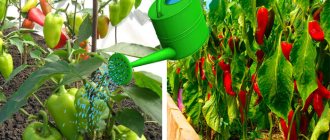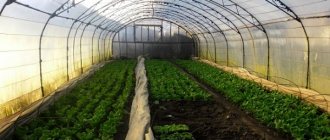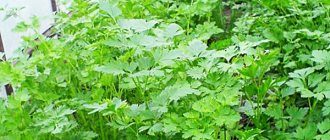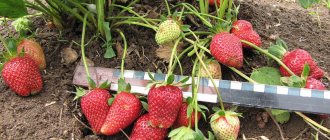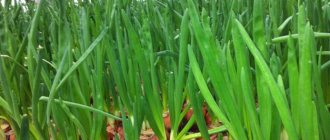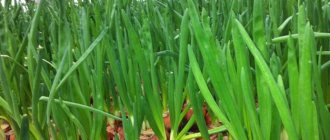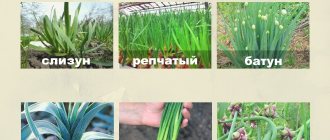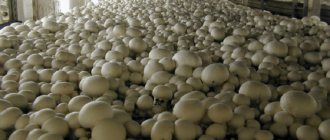Gardeners in the temperate climate zone of Russia prefer to grow sweet bell peppers in polycarbonate greenhouses. To grow this heat-loving vegetable in the weather conditions of the Moscow region, Volga region, Urals and Siberia, special conditions are needed. You can create them for peppers in stationary greenhouses or in greenhouses under covering material. Experienced gardeners get good harvests even from open beds, but in rainy and cold summers this is almost impossible. The peppers do not receive enough heat and do not have time to fully ripen before the end of the season.
Why and why peppers are grown in a greenhouse
Due to the fact that most pepper varieties take quite a long time from the appearance of full shoots to the biological ripening of the fruit, which sometimes reaches 150 days, growing it in a greenhouse often has no alternative. This is especially true for regions with short summers and cold climates.
Ural and Siberia
In these regions, obtaining a full pepper harvest is possible only in greenhouses or in warm beds under film cover. In conditions of short summer and sharp temperature fluctuations in open ground, it is almost impossible to grow even varieties with relatively short ripening periods.
Middle zone and Moscow region
It is in principle possible to grow peppers in the open ground of these regions, but this is not possible in every season. Often it is necessary to remove fruits at the stage of technical maturity and lose part of the harvest. Therefore, film or polycarbonate greenhouses are used everywhere here for growing peppers.
Northern regions of Russia
Glazed, heated greenhouses are the only possible option for growing peppers in harsh conditions.
Table: advantages and disadvantages of growing peppers in a greenhouse
| Advantages | Flaws |
| Extension of growing season | Relatively high costs for greenhouse construction |
| Getting early harvests | The need for labor and financial costs for maintaining a greenhouse |
| Leveling possible temperature changes | Quite complex and time-consuming plant care |
| Possibility of growing perennial peppers in heated greenhouses | |
| The only option for obtaining high-quality seedlings in large quantities |
Harvesting
There are two degrees of ripening of peppers - technical and biological ripeness. They are distinguished by the appearance of the fruit. When fully ripe (biological), the peppers become bright and acquire a certain (varietal) orange, red, yellow, and chocolate color.
1-2 months before this, preparatory (technical) ripeness begins; at this time, the fruits are unevenly colored in pale reddish, yellowish, brownish shades. They say about such peppers “they have acquired commercial ripeness.” They can be safely collected, transported, and sold to customers.
Attention!
Experienced gardeners receive 2-3 harvests during the season. Such a reward can only be earned if all recommended rules are followed.
Preparatory stage
Preparing a greenhouse for planting is a rather expensive and time-consuming process.
The soil
On fertile soils, you can get by with simply applying fertilizer, but more often you have to make high or combined beds in the greenhouse. For this:
- They dig a hole around the perimeter of the bed, 20-30 cm deep. If the soil under the greenhouse is quite fertile, then skip this point.
- A fence 20-30 cm high is installed along the same perimeter. It can be made of boards, flat or corrugated slate, tiles, etc.
Greenhouses often have high beds
- The internal volume of the resulting reservoir is filled with nutrient soil. Various options are acceptable depending on the capabilities of the gardener; the only important thing is that the soil is loose, permeable and fertile. Its composition could, for example, be like this:
- chernozem (imported) - 3 parts;
- high-moor peat - 1 part;
- humus - 1 part;
- sand - 1 part.
- Additionally, in the fall, superphosphate (50-60 g/m2) and wood ash (2-3 l/m2) are added to the digging.
Irrigation system equipment
Watering is an important part of pepper care. It can be carried out in various ways, the choice of which depends on the preferences and financial capabilities of the gardener.
Traditional watering
This is the cheapest, but also the most labor-intensive option. To carry it out, after planting the seedlings, grooves are formed along the beds, which are subsequently periodically filled with water manually or from a hose. This method is time-tested and works well for watering peppers. Its only drawback is the formation of a crust when the soil dries out, which requires loosening it after each watering. Since warm water is required for irrigation, special containers are installed in the greenhouse (or next to it) to accumulate and heat it.
Drip irrigation
Drip irrigation systems can significantly simplify the watering procedure. For this purpose, special drip tapes are used, which are laid along the rows of plants at a distance of 10-15 cm from the stems on both sides. Water is supplied to them by gravity (for this, the containers must be raised quite high - 1-1.5 m) or using a pump. If necessary, add water-soluble fertilizers to the water for irrigation. With this method, moisture enters the soil slowly and directly to the roots; a crust is practically not formed.
Tapes for drip irrigation are laid on the beds immediately after planting the seedlings
Watering with oozing hoses
This is an innovative technology, which is a type of drip irrigation. Its peculiarity is the use of special hoses made of porous rubber instead of drip tape. In this case, droplets of moisture are released over the entire surface of the hose, creating a continuous moistened strip. Other advantages of this technology:
- its operation does not require high water pressure - it can flow by gravity even from a low-standing container;
Water from a oozing hose is released over its entire surface
- durability of the hoses - at the end of the season they can be easily rolled into coils; they can withstand temperatures down to -30 °C during storage.
Caring for peppers in a greenhouse
Like any plant in a greenhouse, pepper requires constant attention and care.
Watering and mulching
Maintaining optimal soil moisture. To control it, it is not necessary to purchase expensive devices; it is enough to ensure that a crust does not form on the surface of the soil, and also that the soil does not sour. Typically, the interval between waterings is 2-3 days, but in extreme heat, daily watering may be necessary. In order to reduce the total number of waterings and loosening, the soil is mulched using available materials:
- straw;
- hay;
- peat;
- sunflower husk;
- compost, etc.
By rotating, the mulch additionally enriches the soil with nutrients.
Feeding
Peppers begin to be fed 2-3 weeks after planting the seedlings in the greenhouse. In this case, fertilizers are applied in liquid form - this way they are absorbed as quickly as possible. At first, plants need enhanced nitrogen fertilizing, which promotes the rapid accumulation of green mass and stem growth. The best nitrogen fertilizer is considered to be an infusion of mullein or chicken droppings, which are easy to prepare yourself. To do this, the selected component is loaded into a barrel (it is better to place it outside the greenhouse in a sunny place) and filled with water. After 5-7 days of fermentation, the strained concentrate is used to fertilize peppers, diluting it with water 5 times (chicken manure - 10 times). 1 liter of fertilizer is poured onto each bush. After 7-10 days, you should feed the peppers with potassium, which can be added in the form of an infusion of wood ash (3 liters per bucket of water infused for 2-3 days) at a rate of 1 liter per bush.
Mullein infusion is a natural nitrogen fertilizer
If it is not possible to prepare fertilizers yourself, then you can use urea (20-30 g/l) and potassium monophosphate (10-20 g/l), pre-dissolving them in water (it is convenient to add them to a barrel for drip irrigation). In the future, these feedings are carried out at intervals of 2 weeks, alternating organic and potassium.
Shaping, gartering and pinching
Low-growing varieties of pepper, as a rule, do not need such procedures, although it is recommended to remove leaves and stepsons from them before the first fork. All other peppers are usually formed into 2 stems, and the stepsons growing inside the crown are removed. If necessary, the stems are tied to pre-installed supports.
It is better to form peppers into 2 stalks
Video: shaping peppers
Lighting
Peppers can be grown in spring-summer greenhouses without additional lighting. If autumn or extended rotations are expected, then the installation of an additional lighting system will be required. For normal growth and development of peppers, they need 12-14 hours of daylight, just as was indicated for seedlings.
Take time to form bushes
Forming a bush allows you to direct all the forces of the plant in the “right direction”. If this is not done, the pepper will begin to spend nutrients on growing green mass, and not on the formation of ovaries, when such a need really arises. The main stages of the formation of pepper bushes:
When the first flowers appear on the seedlings, they are removed so that the young plant spends nutrients on strengthening the bush.
As soon as the plant planted in the ground adapts to new conditions, begin forming bushes. To do this, remove all the lower shoots up to the first fork, and along with them, carefully separate the crown flower from the stem.
Reduce the number of ovaries to 20 per bush so that the plant does not waste its energy on “extra” fruits.
To ensure that the last pepper crop has time to fully ripen, remove all new flowers at the end of August.
The crown flower is the flower that forms at the first fork of the bush.
- How and why to plant peppers
Understanding the formation of peppers is very simple. You just have to carefully examine the bushes.
Diseases and pests common when growing peppers in a greenhouse
Greenhouse peppers are susceptible to some diseases and pest attacks. As a preventive measure, a few days before planting, the soil in the beds is treated with Farmayod, dissolving 10 ml of the drug in 10 liters of water. The consumption rate for treatment is 2 l/m2. This drug kills all soil bacteria, including beneficial ones. Therefore, 3-5 days after treatment, the soil is watered with solutions of Siyanie or Baikal EM1 preparations to restore the microflora.
The drug Baikal EM1 allows you to quickly restore soil microflora after treatments
To prevent fungal diseases on the plants themselves, the biofungicide Fitosporin M is used, which can be sprayed on peppers an unlimited number of times with an interval of 2 weeks.
Table: probable pests and diseases of peppers in greenhouses
| Disease/pest | Signs | Drugs for treatment/control |
| Blackleg | Rotting of the stem at the base, drying out of the bush | Farmayod, potassium permanganate (soil treatment) |
| Gray rot | Wet brown spots on the bottom of the stem | Fundazol, Skor, Previkur, etc. |
| Late blight | The appearance of brown spots on the leaves and fruits, then the leaves curl and dry out | Quadris, Gamair, Fitosporin M, etc. |
| Cladosporiosis |
| Screen, Barrier |
| Aphid | Small black insects on the undersides of leaves | Fitoverm, Fitolavin, Iskra Bio |
| Spider mite | Small yellow dots on leaves | |
| Colorado beetle | Larvae and beetles on leaves, holes in leaves | Decis, Commander |
Sowing seeds for seedlings
After the seeds have gone through all the necessary processing steps, you can begin to prepare the container and soil. It is advisable to sow the seeds in large boxes, on the bottom of which a plastic film is spread. Soil is poured into the container. Small holes or trenches are made in the soil mixture into which the seeds will be sown. After sowing the seeds, the soil is watered moderately. The boxes are covered with non-woven material and installed in a warm place. Before the first shoots, the film must be periodically removed to ventilate the soil and remove condensation that has accumulated on it. After the first shoots, the polyethylene is removed, and the container itself is transferred to the south side or to the street.
Mistakes when growing peppers in a greenhouse
Novice gardeners can make mistakes when growing peppers in a greenhouse, which often lead to unpleasant consequences.
Temperature changes
Sharp fluctuations in day and night temperatures inhibit the growth of peppers and can cause blossom end rot.
High humidity
Excess moisture provokes various fungal diseases, such as:
- blackleg;
- various rots;
- late blight
Thickened plantings
Exceeding planting standards per unit area leads to nutritional deficiency, increased humidity and dampness, deterioration of lighting, which, in turn, causes fungal diseases, chlorosis, and deterioration in fruit quality.
Unbalanced diet
Deficiency or excess of various nutrients are equally harmful to plants. Therefore, the established norms for their application should be observed. It is easier for a beginner to use complex fertilizers that contain all the necessary elements in the quantities required for pepper.
Complex fertilizer for peppers contains all the necessary elements in balanced quantities.
Peppers don't turn red
There may be several reasons for this:
- Peppers were planted too late in their ripening period and did not have time to ripen in a particular region.
- Insufficient lighting.
- Low air temperature in the greenhouse.
- Potassium deficiency.
- Excess nitrogen.
